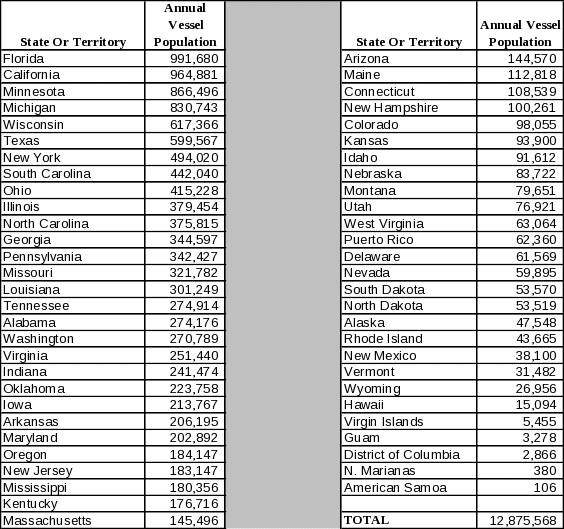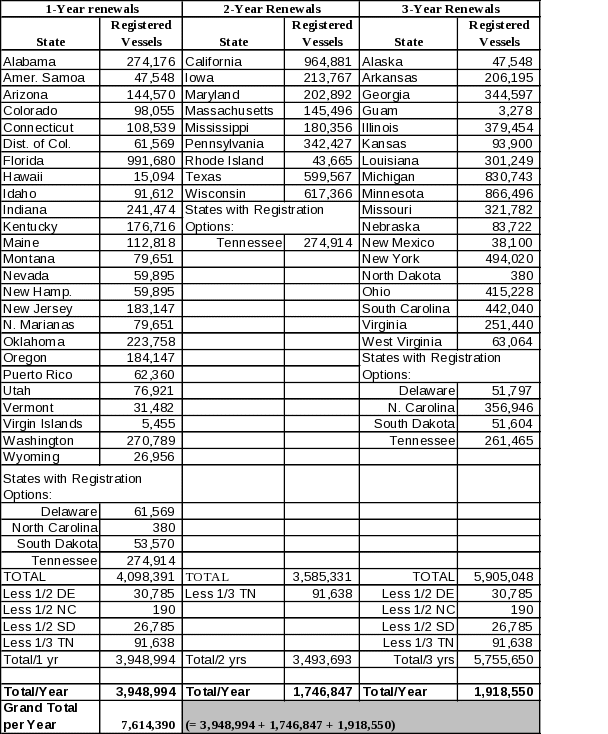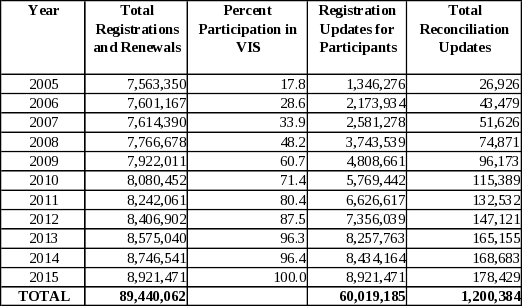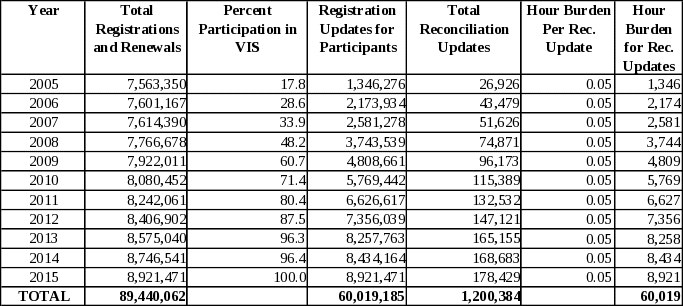1625-0070_ss
1625-0070_SS.doc
Vessel Identification System
OMB: 1625-0070
1625-0070
Supporting Statement
for
Vessel Identification System
A. Justification:
1. Circumstances that make the collection of information necessary.
The Secretary of Homeland Security (formerly Transportation) is required by Congress to establish the vessel identification system (VIS); to prescribe the manner and form for participating states and territories to make information available to VIS; to establish guidelines for state and territory vessel titling systems; and to establish procedures for certifying compliance with those guidelines (46 USC chapters 125, 131, and 313). The Secretary has delegated to the U.S. Coast Guard the authority to implement VIS. State and territory participation in VIS is entirely voluntary. However, to participate, states and territories must comply with certain requirements to ensure the integrity and uniformity of the information provided to VIS.
VIS will comprise a nationwide information system for identifying recreational, commercial, and public vessels that are numbered in accordance with 46 USC Chapter 123 or titled under the laws of a state or territory. VIS will include information identifying vessels and vessel owners, and information to assist law enforcement officials in the investigation of stolen vessels or other legal investigation, such as fraud. Furthermore, individuals who borrow money to purchase a vessel in a state or territory that both participates in VIS and holds certification of compliance (with guidelines for state or territory titling systems) will be deemed to have preferred mortgage status.
The regulations governing VIS have been effective since April 2001. The most significant implementation issue facing VIS is ensuring that each State provides the accurate and timely data necessary for VIS to be operationally effective. The Coast Guard plans to harmonize terminology governing the Standard Numbering System, the Vessel Identification System, and the Casualty or Accident Report. This rulemaking, currently entitled “Administrative Changes to Numbering of Vessels and Reporting of Casualties,” is at the workplan stage.
Any changes in information collection burden due the above rulemaking will be addressed in a separate request for OMB approval under that rulemaking.
This information collection supports the following strategic goals:
Department of Homeland Security
Prevention
Service
Coast Guard
Mobility
Marine Safety, Security and Stewardship Directorate (CG-5)
Reduce the number and/or impact of waterways impediments
2. Purpose of the Information Collection.
All 50 states and 6 territories have the opportunity to participate in the VIS program. (The 6 territories are Guam, Puerto Rico, U.S. Virgin Islands, American Samoa, District of Columbia, and Northern Mariana Islands.) However, to participate, a state or territory must comply with certain requirements to ensure the integrity and uniformity of the information provided to VIS. Each participating state or territory is required to collect and provide information to identify:
registered or titled vessels, 2) vessels' owners, and 3) claims against titled vessels. Currently
that information is required to participate in the Standard Numbering System, which all States but Alaska participate in. The Coast Guard numbers Alaskan vessels.
Information is collected from registration summary updates and reconciliation updates.
Registration Summary Updates:
It is envisioned that at the end of each workday, a State participating in VIS will submit a summary update of the new registrations or registration renewals to VIS, which will include all registration changes for that day. The Coast Guard estimates this is done for 5 days, for 50 weeks. Consequently, the Coast Guard expects 250 registration summary updates per year from each participant. We do not know the order that States will begin to participate in VIS. However, we know that there were 27 participants as of 2008 and we assume an additional 7 will begin participating in 2009, 6 in 2010, 5 in 2011, 4 in 2012, 3 in 2013, 2 in 2014, and 2 in 2015. Over the eleven-year period from the beginning of 2005 through 2015, we estimate there would be a total of 94,000 registration summary updates, for an average of 8,545 per year. See Table 1.
Table 1: Number of Registration Summary Updates
|
Number |
Summary Updates |
Total Summary |
Year |
of Participants |
Per Participant |
Updates |
2005 - 2007 |
19 |
250 |
4,750 |
2008 |
27 |
250 |
6,750 |
2009 |
34 |
250 |
8,500 |
2010 |
40 |
250 |
10,000 |
2011 |
45 |
250 |
11,250 |
2012 |
49 |
250 |
12,250 |
2013 |
52 |
250 |
13,000 |
2014 |
54 |
250 |
13,500 |
2015 |
56 |
250 |
14,000 |
TOTAL |
|
|
94,000 |
Reconciliation Updates:
If a State improperly inputs a new registration or registration renewal, an error report is generated from VIS. A State that receives an error report will be required to correct the error by producing a reconciliation update. The Coast Guard estimates a 2% error rate.
The number of registration changes (and it follows, reconciliation updates) is a function of the number of registered vessels. In 2007, the latest year for which there is available data,, there were 12,875,568 registered vessels. See Table 2.
TABLE 2: REGISTRATION STATISTICS AND ANNUAL TRANSACTIONS

Source: Registration Statistics from U.S. Coast Guard, 2007.
The registration cycles of States vary. For example, whereas Florida requires registration to be renewed every year, California requires registration to be renewed every two years, and Minnesota every three years. Tennessee renews registrations every one, two and three years. From the number of registered vessels and the renewal cycles, we estimate that there were approximately 7,614,390 changes in registration (new registrations and renewals) in 2007. See Table 3.
Table 3: Registration Renewal Cycles (2007 figures)

As previously stated, we know that there were 27 participants as of 2008 and we assume an additional 7 will begin participating in 2009, 6 in 2010, 5 in 2011, 4 in 2012, 3 in 2013, 2 in 2014, and 2 in 2015. Over the past ten years, the number of registered vessels has grown at an average rate of 2% per year. Thus, from 7,614,390 registration changes in 2007, we expect 7,766,678 for 2008 (7,766,678 = 7,614,390 x 1.02). However, as we know, 27 (or about 48.2%) of the States participated in VIS during 2008, we also expect only 3,743,539 registration changes from VIS participants that year (3,743,539 = 7,766,678 x 0.482).
We assume that 2% of those registration changes are improperly recorded and will produce an error report. Consequently, over the eleven-year period from the beginning of 2005 through 2015, we estimate there would be 1,200,384 reconciliation updates, for an average of 109,126 reconciliation updates per year. See Table 4.
Table 4: Frequency of Reconciliation Updates

The total average number of responses would be 117,671 per year (8,545 for registration summary updates and 109,126 for reconciliation updates).
3. Considerations of the use of improved information technology to reduce the burden.
100% of each participating State or Territory's daily transactions will be recorded electronically and automatically included in VIS. Furthermore, 100% of the reconciliation reports will be transmitted electronically. The support and maintenance of VIS will be combined with other Coast Guard programs at USCG Operations Systems Center (OSC), Martinsburg, West Virginia.
4. Efforts to identify duplication. Why similar information available cannot be used.
In 2007, there were approximately 12.9 million registered vessels (in the 50 states and 6 territories), and most of these vessels were recreational vessels. Although the Coast Guard has a nationwide database for documented vessels, recreational vessels are, with rare exceptions, not documented. There has never been a nationwide database of recreational vessels, although recreational vessels far outnumber commercial and public vessels. VIS will, for the first time, create a nationwide database of recreational, commercial and public vessels.
Title 33 CFR 187 is based on the suggested process of vessel titling by the National Association of State Boating Law Administrators (NASBLA). Consequently, it is the intent of VIS to request information that is normally gathered by a state or territory when titling a recreational vessel. With VIS, federal agencies and participating states and territories will have access to the national database.
5) Methods used to minimize the burden to small businesses if involved.
This information collection does not have an impact on small businesses or other small entities.
6. Consequences to the Federal program if collection were not conducted or conducted less frequently.
The consequence to the federal Vessel Identification System of not collecting registered or titled vessel information would be the failure to enact the legislative intent of Public Law 100-710 (46 USC 125, 131, and 313). All data that 33 CFR 187 seeks to secure will be generated by participating states and territories. As of 2008, approximately 37 states and territories have vessel titling systems. There has been a move, sponsored by the NASBLA, to have all states and territories title vessels.
The primary benefits of VIS will come from its ability to serve as a tracking device much like the Vehicle Identification Number found in automobiles. As a tracking device, the benefits of VIS will be in:
the recovery of stolen or missing vessels, which will benefit boat owners, local and state law enforcement agencies and boat insurers;
the purchase of a vessel, which will make it less likely to unknowingly purchase a stolen vessel, which can be a financial disaster if the rightful owner shows up to claim it; and
the discovery of liens, unpaid taxes, and claims that are lodged against a vessel, and that can become the unexpected responsibility of the new owner.
Without VIS, these benefits are not realized.
7. Special circumstances that require collection to be conducted in an inconsistent manner.
This information collection is conducted in manner consistent with the guidelines in 5 CFR 1320.5(d)(2).
8. Solicitation of Comments.
A 60 day (See [USCG-2009-0115], March 12, 2009, 74 FR 10752) and 30 day (See [USCG-2009-0116], June 24, 2009, 74 FR 30102) Notice was published in the Federal Register to obtain public comment on these collections. The USCG has not received any comments on these information collections.
9. Provide any payment or gift to respondents.
There is no offer of monetary or material value for this information collection.
10. Assurances of confidentiality provided to respondents.
There are no assurances of confidentiality provided to the respondents for this information collection.
11. Additional justification for any questions of a sensitive nature.
There are no questions of sensitive language.
12. Estimate of annual hour and cost burden.
The estimated number of respondents is 56. (p. 7)
The estimated number of annual responses is 117,671. (p. 5)
The estimated annual hour burden is 5, 456 hours. (p. 7)
The estimated annual cost burden is $449,144. (p. 8)
This voluntary collection affects the 50 states and 6 territories (56 respondents) that choose to participate in VIS. In the estimation of hour and cost burdens we assume a 100% participation rate by the year 2015.
In 2007, there were 12,875,568 registered vessels and we assume the registered vessel population will grow at an average rate of 2% during from 2007 through 2015.
The costs of this collection are the start-up costs and recurring costs. The start-up costs are one-time costs that are found in the answer to question 13.
Recurring Hour and Cost Burdens:
The recurring hour and cost burdens are the hour and cost burdens of producing registration updates and the hour and cost burdens of producing reconciliation updates.
Registration Summary Updates:
The hour and cost burdens of the registration summary updates over and above the hour and cost burdens currently of the Standard Numbering System are negligible. Because every State but Alaska participates in the Standard Numbering System, we expect the total hour burden and cost burden of the registration summary updates would be negligible.
Reconciliation Updates:
We estimate it will take an average of 3 minutes (or 0.05 hours) to produce a reconciliation update. Over the eleven-year period, the total hour burden for reconciliation updates is 60,019 hours, for an average of 5,456 hours burden per year. See Table 4.
Table 4: Hour Burden for Reconciliation Updates

At a unit labor cost of $31 per hour (Commandant Instruction 7310.1L for a wage equivalent to a GS-4), we estimate the annual cost of reconciliation updates would be $1,860,589 over the eleven-year period (60,019 hours x $31/hour). The average annual cost of reconciliation updates over the eleven year period would be approximately $169,144.
The total cost of VIS over the eleven-year period would be $4,940,589 which is equal to the total costs of the annual reconciliation updates plus the total of the startup costs (see item 13 below).. The total average annual cost would be $449,144. See Table 5.
TABLE 5: VIS HOUR BURDEN AND COST
Year |
Total Hour Burden |
Cost Per Hour |
Recurring Cost |
Start-Up Cost |
Total Cost |
2005 |
1,346 |
$31 |
41,735 |
548,240 |
589,975 |
2006 |
2,174 |
$31 |
67,392 |
332,640 |
400,032 |
2007 |
2,581 |
$31 |
80,020 |
163,240 |
243,260 |
2008 |
3,744 |
$31 |
116,050 |
440,440 |
556,490 |
2009 |
4,809 |
$31 |
149,068 |
385,000 |
534,068 |
2010 |
5,769 |
$31 |
178,853 |
329,560 |
508,413 |
2011 |
6,627 |
$31 |
205,425 |
277,200 |
482,625 |
2012 |
7,356 |
$31 |
228,037 |
218,680 |
446,717 |
2013 |
8,258 |
$31 |
255,991 |
271,040 |
527,031 |
2014 |
8,434 |
$31 |
261,459 |
3,960 |
265,419 |
2015 |
8,921 |
$31 |
276,566 |
110,000 |
386,566 |
TOTAL |
60,019 |
$31 |
$1,860,589 |
$3,080,000 |
$4,940,589 |
Note: Totals may not add due to rounding.
13. Provide an estimate of the annualized capital/start-up costs to respondents.
Much of the information to be included in the VIS database is already collected by states and territories when registering vessels. The start-up cost is the cost of developing the VIS database, interface, and conversion software at the state and territory level. The Coast Guard estimates the average start-up cost per state or territory is $55,000. Because the start-up cost is a one-time cost, we assume it is only incurred during the first year in which a state or territory participates in VIS. The Coast Guard estimates the total start-up cost is $3,080,000 (56 states and territories x $55,000/state or territory = $3,080,000). See Table 5 above. The average annual start-up cost would be $308,000 ($3,080,000/11 years = $280,000/year).
14. Estimates of annualized cost to the Federal Government.
The Coast Guard contracted Computer Services Corporation to develop VIS. The cost of the contract was $2,200,000. It was a one-time cost that has already been incurred.
The Coast Guard estimates the annual cost to support and maintain VIS will be $821,659.
15. Reasons for change in the burden.
The change in burden is an ADJUSTMENT due to a change in vessel population.
16. Plans for tabulation, statistical analysis and publication.
This information collection will not be published for statistical purposes.
17. Approval for not explaining the expiration date for OMB approval.
The Coast Guard will display the expiration date for OMB approval of this information collection.
18. Exception to the certification statement.
The Coast Guard does not request an exception to the certification of this information collection.
B. Collection of Information Employing Statistical Methods:
This section does not apply because the collection of information does not employ statistical methods.
| File Type | application/msword |
| File Title | SUPPORTING STATEMENT FOR |
| Author | zzjward1 |
| Last Modified By | Arthur A. Requina |
| File Modified | 2009-09-29 |
| File Created | 2009-02-04 |
© 2026 OMB.report | Privacy Policy